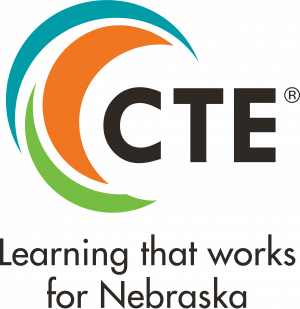Nontraditional & Special Populations

Strategies for Special Population Success
These resources will help you develop plans to address the equity gaps for special populations that you uncovered during your Perkins V reVISION process. Your Perkins V Indicator Report provides you with performance data disaggregated by gender, race, and each of the nine special population groups. Use this resource with your team to identify potential strategies to address the root causes of your identified gaps in participation and performance. Utilize the recommended state and national organizations to support your efforts and to locate similar local organizations that serve students in your community. Target your strategies to address the needs of each of the special population groups to increase the potential for success. With the right support, your students who are members of a special population can achieve amazing results and discover a new world of opportunities.
- Explore how systems, policies, power, language, and social capital reproduce inequalities in your school/college.1
- Learn and use culturally responsive teaching and leadership skills, such as connecting students’ cultural background to instruction and valuing cultural diversity as an asset in the learning environment. 2, 3
- Incorporate student voices into equity audits and development of institutional policies and programs.4
- Implement professional development that builds educator capacity to understand how gender, race, class, language, ethnicity, and ability differences are perceived and treated in the institution and influenced by implicit bias and micro-messaging.5
- Use wise feedback6 and other strategies to help members of special populations develop self-determination,7 self-efficacy8, 9, 10 and a growth mindset.11, 12
- Use Career and Technical Student Organizations (CTSOs) as a way for students to build social capital and networks in which they feel welcome and supported.13
- Ensure that students who are members of special populations participate in work-based learning, supported employment,14 and apprenticeships leading to economically self-sufficient employment.
- Acknowledge, address, and respond to culturally traumatic or celebratory news and events.15
- Use role models/mentoring to reinforce student identity and self-efficacy.16
- Partner with community-based organizations that support each special population group. Give community-based organization and support agencies the opportunity to conduct outreach and provide services on campus so that they are easily accessible and friendly.17
- Involve caregivers in outreach, decision making, and support for members of special populations. Remove barriers to students and their care-givers’ participation such as transportation, child care, translation, location, and scheduling.18
- Implement case management with students who are members of a special populations to ensure that services are coordinated and no one falls through the cracks.19
- Ensure that all physical spaces are accessible, including transportation, parking, reach, curbs, floor resistance, table heights, turn space, door width, and location.20
- Provide professional development with faculty on strategies for providing accommodations for students with disabilities, including how to protect privacy and reduce stigma.21
- Implement Universal Design for Learning and differentiated instruction with all students in all classrooms.21
- Use para-professionals and other special education service providers to support students with disabilities’ learning both in and out of the classroom.21
- Request and implement approved accommodations when students with disabilities are taking industry-based certification or licensure exams.21
- Increase Individualized Education Program (IEP) effectiveness by including all individuals who support a student, including career and technical education (CTE) teachers. Train CTE teachers on how to understand a student’s IEP, provide appropriate accommodations, raise expectations, and decrease bias.21
- Create opportunities and ways that parents and students with disabilities can advocate for themselves and challenge low expectations, such as secure reporting or peer advocates.21
- Build relationships with companies that have successfully employed students with disabilities and ask them to support your outreach to new employers. Use the resources available through the Nebraska Office of Vocational Rehabilitation to assist with work-based learning experiences and employment placement.22
- Develop relationships with students and their families that promote trust, maintain privacy, and build cooperation as a crucial step before introducing content.23,24
- Provide free books, materials, tools, uniforms, and other resources necessary for success in a CTE program. Pay dues, activity fees, and other costs for students who are low-income to participate in CTSOs.18
- Make financial aid and scholarships easily accessible, and provide assistance with application processes to ensure their completion.18
- Provide transportation, transportation vouchers, bus passes, or mileage reimbursement. Ensure that transportation is available at the right time and in the right location so that students are safe.18
- Ensure that students have access to healthy food and nutrition by providing meals at school and all family events. Locate local food bank distribution sites for families on campus.18
- Offer affordable or free licensed child care on-site in coordination with the times and locations of all programs.18
- Have students manage a free-access, business clothes closet for interviews or work. Seek donations from the community.18
- Expose students to nontraditional career options early (elementary grades) to broaden their horizons about what careers are available to them. Children develop gender career stereotypes as early as age 3.25
- Address math anxiety and spatial visualization skill development for students pursuing nontraditional fields in STEM through instructional scaffolding and tutoring.26
- Offer informal, low-risk, hands-on, skill-development experiences for students to try skills in a nontraditional program, especially for girls who need to develop skills before expressing interest. These activities can include a brown-bag lunch, after-school workshop, maker space experience, or summer camp.16
- Review curriculum and guidance policies and practices for bias. Include gender and culturally relevant examples, projects, instructional materials, texts, websites, language, and images.27,28,29
- Implement equitable cooperative learning strategies that ensure rotation of responsibilities to all group members. Manage grouping configurations to eliminate tokenism or stereotyping.30
- Ensure that safety equipment, safety clothing, uniforms, and tools are available in small to large sizes to accommodate a person of any stature.31
- Form informal support groups in which students can share their experiences and build community with other students pursuing a nontraditional career.16
- Enroll nontraditional students in cohorts—three or more in the same section—to combat tokenism or gender/racial isolation and encourage peer support and cohort engagement.16
- Enforce civil rights and sexual harassment policies and practices—ignoring is the same as condoning. Ensure that students are aware of reporting procedures and that their privacy will be protected.32
- Make it personal. Personally invite students who are underrepresented to enroll in your program so that they feel welcome.33
- Do not isolate teen parents in separate programs where access to CTE is not available. Access to CTE programs that lead to employment in an occupation with family-sustaining wages is critical.34
- Allow for attendance flexibility and alternative course completion options, especially for teen parents who may be struggling to manage parenting responsibilities.35
- Provide transportation for the teen parent’s child to child care and the student to school, ideally in the same location.35
- Provide parenting/child development classes for teen parents to develop coping skills and stay in school.35
- Offer affordable or free licensed child care on-site in coordination with the times and locations of all programs.35
- Offer courses in many ways—asynchronous online, synchronous online, face-to-face, hybrid—at different times of the day and in different locations to accommodate single parenting responsibilities and schedules.36
- Ensure that faculty are accessible by holding unusual office hours, being available online, and communicating in a timely manner via email.36
- Conduct family-friendly outreach activities, and incorporate family into student events.36
- Conduct single parent support groups and/or study groups to build a community of support and social networks.36
- Help single parents develop skills to balance work/family/school/life and build financial literacy by integrating these skills into the curriculum and supplementing with workshops, online training, and newsletter content.36
- Coordinate services with the Workforce Investment Opportunity Act (WIOA) programs and services through Nebraska’s Workforce Development System’s adult/dislocated worker program, youth program, and the American Job Center network.37
- Help students identify transferrable skills to connect instructional relevance and build opportunity in a high-demand nontraditional career field that supports economic self-sufficiency and offers good benefits.16
- Provide support services such as child care, transportation, and financial aid for books, tuition, materials, and tools.18
- Organize support groups and study groups that build community and social capital. Provide transportation, child care, and food to encourage participation.18
- Provide career planning services such as resume writing, goal-setting, interview skills, stress management, job-shadowing, and work-based learning.18
- Identify employment-based training such as work-study, subsidized employment, and apprenticeships that provide wages while attending school.38
- Utilize flexible learning approaches including online learning, alternative scheduling in the evening and on weekends, and independent learning.39
- Offer short-term programs with stackable certifications, credentials, or licensure that have value in the workplace.39,40
- Engage families and community in supporting English learners’ engagement in CTE and CTSOs.41
- Provide interpreters for students and their families.18
- Use the gradual release of responsibility model or scaffolded instruction to build student English proficiency.42
- Support English learners with scannable technology if students have smart phones, such as, word walls, scannable vocabulary lists, and audio directions.43 Use technology to facilitate language translation such as visual dictionaries and translation apps.
- Facilitate collaboration between CTE and English as a Second Language (ESL) teachers.44
- Connect content learning to language acquisition. Position English learners as competent classroom community members by sharing ideas in pairs, using cooperative learning strategies, and engaging in classroom discussion.45,46
- Provide instructional materials in multiple languages or implement a flipped classroom with prep materials in the English learner’s language.47
- Use instructional practices that support English learners’ understanding, such as providing hands-on demonstrations, visual clues to reinforce spoken or written words, and graphic organizers; increasing wait time when asking questions; allowing students to seek clarification; encouraging English learners’ participation in social and academic discussions; and focusing on content of student’s response and not on pronunciation or grammatical errors.48
- Create student cohorts or learning communities in which students can learn from each other and help older students who have been out of school for a long time and are not familiar with how to navigate the institution.49
- Have a process in place to identify students experiencing homelessness, including training and professional development opportunities for staff so they can identify and meet these student’s needs.50
- Connect with the Nebraska Office of Education of Homeless Children and Youth authorized by the McKinney-Vento Homeless Assistance Act (MVHAA). Ensure that students experiencing homelessness and their families know their rights under the MVHAA.51,52
- Know what support services are available in your district under Title I, Part A of the Every Student Succeeds Act that help students experiencing homelessness maximize credit accrual and complete high school.53
- Provide enriched supplemental instruction, tutoring, credit recovery, partial coursework, independent study, and online learning options for students experiencing homelessness to keep up or catch up with their learning.53
- Become familiar with Nebraska state laws about reporting suspected abuse or neglect, or a suspected runaway.54
- Provide access to free meals, shower and laundry facilities, a secure place to store personal belongings, quiet place to study, free school supplies, and access to technology and the internet.55
- Coordinate school and community resources that provide trauma-informed wraparound services such as transportation, referrals to health care, shelters, housing, and employment.56
- Access financial support for dues, activity fees, and transportation resources through the MVHAA for students experiencing homelessness for extracurricular activities and participation in CTSOs.57,58
- Ensure access to school-based programs such as Upward Bound, Gifted Ed, Special Ed, AP courses, CTE, athletics, band, theater arts, and other programs.55,58
- Students experiencing homeless may be chronically absent. Pair at-risk students with mentors who encourage them to attend school every day, and provide accountability through attendance monitoring and follow-up with students and parents/guardians when students miss school to determine the cause of the absence and how that barrier can be overcome.59
- Revise policies that may inadvertently decrease student attendance such as severe penalties for tardiness and/or suspending students from school as a result of excessive absences.59
- Be familiar with the requirements of the Fostering Connections to Success and Increasing Adoptions Act of 2008 as it relates to education.60
- Learn about your students in foster care. They may have experienced abuse, neglect, and multiple placements, so safety is their number one priority—not school. Build a relationship of trust with them and their foster family.61
- Be flexible with homework, due dates, and testing, and stay in touch with foster parents to know when a student will have a birth parent or biological family member visitation because these times will create emotional unrest.61
- Be an advocate and role model for your students in foster care.61
- Ensure access to school-based programs such as Gifted Ed, Special Ed, AP courses, CTE, athletics, band, theater arts, and other programs.61
- Help students who are transitioning out of foster care to develop a transition plan using the Foster Care Transition Toolkit.62 Foster care benefits terminate at age 21 in Nebraska.
- Connect students with federal TRIO63 programs at your local community college. These include Upward Bound64, Talent Search,65 Educational Opportunity Centers66, and Student Support Services.67
- Provide tutoring, counseling, mentoring, cultural enrichment, work-study, and financial literacy training.68
- Understand the unique needs of a child with a parent in the military on active duty during deployment. Promptly refer a student for counseling who continues to show signs of stress, inability to function in school, or has high levels of emotional response after a family member deploys.15
- Create support groups for children of military families.15
- Retain classroom routines and maintain predictable, structured class schedules.15
- Reinforce safety and security by protecting students from exposure to frightening situations and reminders of their parents’ deployment. Maintain objectivity by responding to events in a calm and caring manner.15
- Participate in outreach activities at a Base Exchange in the summer.69
- Help students access free, online tutoring and homework help at military.tutor.com.
- Use competency checklists that students can share with their next school to ensure their continued learning in a similar CTE program, if their family moves due to deployment or reassignment.71
- Be familiar with the education support services available from the military branch your student’s parent(s) serve. Know the local point of contact. The Veteran’s Administration’s Survivors’ and Dependents’ Educational Assistance program provides education and training opportunities to eligible dependents and survivors of certain Veterans.72
Additional Resources
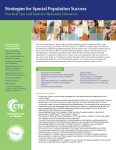 Strategies for Special Population Success Guide
Strategies for Special Population Success Guide
This resource will help you develop plans to address the equity gaps for special populations that you uncovered during your Perkins V reVISION process.
Equity in Youth Apprenticeship Programs Toolkit 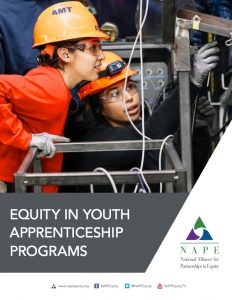
The National Alliance for Partnerships in Equity offers research-based, strategy-driven, practical-application-focused professional development services that equip educators and workforce professionals with tools to address specific school needs related to equitable learning environments, student academic success and ultimately, college and career readiness.
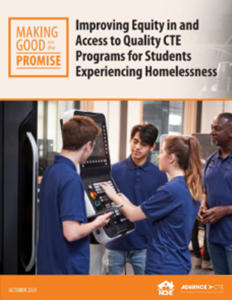 Improving Equity in and Access to Quality CTE Programs for Students Experiencing Homelessness
Improving Equity in and Access to Quality CTE Programs for Students Experiencing Homelessness
Intentional and early collaboration between state and local leaders and state coordinators for homeless education is vital to developing solutions that ensure success in Career Technical Education (CTE) programs for learners experiencing homelessness.
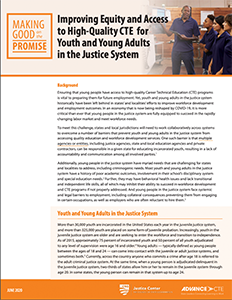 Making Good on the Promise: Improving Equity and Access to High-Quality CTE for Youth and Young Adults in the Justice System
Making Good on the Promise: Improving Equity and Access to High-Quality CTE for Youth and Young Adults in the Justice System
Intentional and early collaboration between state and local leaders and state coordinators for homeless education is vital to developing solutions that ensure success in Career Technical Education (CTE) programs for learners experiencing homelessness.
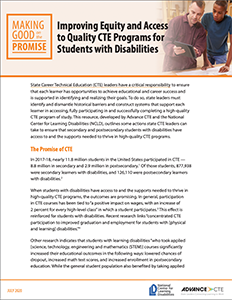 Improving Equity and Access to Quality CTE Programs for Students with Disabilities
Improving Equity and Access to Quality CTE Programs for Students with Disabilities
Advance CTE and the National Center for Learning Disabilities (NCLD) identify five actions state CTE leaders can take to ensure that secondary and postsecondary students with disabilities have access to and the supports needed to thrive in high-quality CTE programs.



